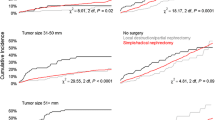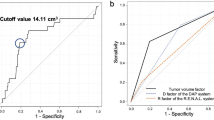Abstract
Objective
It is not yet elucidated whether the symptoms related to renal cell carcinoma have a strong effect on intraoperative complications or survival. We aimed to investigate this association in a cohort of renal cancer patients operated on between June 1997 and December 2004 at the Department of Urology, Semmelweis University School of Medicine.
Patients and methods
Among 363 consecutive patients with renal masses treated at our institution, only 200 (55.3%) were truly asymptomatic and completely incidental (group A). Among the 259 patients with incidentally detected tumors, 59 (16.1%) had symptoms that were probably related to the renal lesion according to a reviewed history (group B) and 104 patients (28.6%) presented for symptoms related to renal cell cancer (group C).
Results
Patients in group B had a higher risk for weight loss (P < 0.0001) and flank pain (P = 0.063), lower risk for symptoms related to distant metastases, while their outcome was not significantly different from group C. The collapsed group (B + C) had an increased risk for metastasis (P = 0.002), higher stage (P = 0.001), and intraoperative complications (P = 0.046) compared to group A according to a logistic regression. The presence of symptoms was significantly related to the overall survival using the Kaplan–Meier method (P < 0.0001).
Conclusions
Weight loss and flank pain were frequently neglected as a possible symptom of renal cancer by the patients. An easily accessible parameter (the presence of symptoms) was independently related to intraoperative complications and survival in renal cancer patients.


Similar content being viewed by others
References
Jemal A, Siegel R, Ward E et al (2007) Cancer statistics, 2007. CA Cancer J Clin 57:43–66
Hock LM, Lynch J, Balaji KC (2002) Increasing incidence of all stages of kidney cancer in the last 2 decades in the United States: an analysis of surveillance, epidemiology and end results program data. J Urol 167:57–60
Lovász S, Romics I (1998) Interleukin-2 (IL”) terápia a metasztatizáló veserák kezelésében. In: Romics I, Goepel M (eds) A here és vesedaganatok diagnosztikája és terápiája, 1st edn. Akadémiai Kiadó Budapest, Hungary
Touloupidis S, Papathanasiou A, Kalaitzis C et al (2006) Renal cell carcinoma: the influence of new diagnostic imaging techniques on the size and stage of tumors diagnosed over the past 26 years. Int Urol Nephrol 38(2):193–197. doi:10.1007/s11255-005-4762-4
Lightfoot N, Conlon M, Kreiger N et al (2000) Impact of noninvasive imaging on increased incidental detection of renal cell carcinoma. Eur Urol 37:521–527. doi:10.1159/000020188
Schips L, Lipsky K, Zigeuner R et al (2003) Impact of tumor-associated symptoms on the prognosis of patients with renal cell carcinoma: a single-center experience of 683 patients. Urology 62:1024–1028. doi:10.1016/S0090-4295(03)00763-5
Ficarra V, Prayer-Galetti T, Novella G et al (2003) Incidental detection beyond pathological factors as prognostic predictor of renal cell carcinoma. Eur Urol 43:663–669
Zugor V, Fridel S, Lausen B et al (2008) Renal cell carcinoma under 35 years of age: comparison of survival rates for symptomatic and asymptomatic patients. Int Urol Nephrol 40(2):289–293. doi:10.1007/s11255-007-9274-y
Ljungberg B, Hanbury DC, Kuczyk MA et al (2007) Renal cell carcinoma guideline. Eur Urol 51:1502–1510. doi:10.1016/j.eururo.2007.03.035
Lam JS, Belldegrun AS, Pantuck AJ (2006) Long-term outcomes of the surgical management of renal cell carcinoma. World J Urol 24:255–266. doi:10.1007/s00345-006-0055-5
Wotkowicz C, Libertino JA (2007) Renal cell cancer: radical nephrectomy. Br J Urol Int 99:1231–1238
Kovacs G, Akhtar M, Beckwith BJ et al (1997) The Heidelberg classification of renal cell tumours. J Pathol 183:131–133. doi:10.1002/(SICI)1096-9896(199710)183:2<131::AID-PATH931>3.0.CO;2-G
Ljungberg B, Alamdari FI, Stenling R et al (1999) Prognostic significance of the Heidelberg classification of renal cell carcinoma. Eur Urol 36:565–569. doi:10.1159/000020049
Lopez-Beltran A, Scarpelli M, Montironi R et al (2006) 2004 WHO classification of the renal tumors of the adults. Eur Urol 49:798–805. doi:10.1016/j.eururo.2005.11.035
Steiner T, Knels R, Schubert J (2004) Prognostic significance of tumour size in patients after tumour nephrectomy for localised renal cell carcinoma. Eur Urol 46:327–330. doi:10.1016/j.eururo.2004.06.003
Minardi D, Lucarini G, Mazzucchelli R et al (2005) Prognostic role of Fuhrman grade and vascular endothelial growth factor in pT1a clear cell carcinoma in partial nephrectomy specimens. J Urol 174:1208–1212. doi:10.1097/01.ju.0000173078.57871.2d
Lam JS, Breda A, Belldegrun AS et al (2006) Evolving principles of surgical management and prognostic factors for outcome in renal cell carcinoma. J Clin Oncol 35:5556–5575
Pantuck AJ, Zisman A, Rauch MK et al (2000) Incidental renal tumors. Urology 56:190–196. doi:10.1016/S0090-4295(00)00655-5
Gudbjartsson T, Thoroddsen A, Petursdottir V et al (2005) Effect of incidental detection for survival of patients with renal cell carcinoma: results of population-based study of 701 patients. Urology 66:1186–1191. doi:10.1016/j.urology.2005.07.009
Hellsten S, Johnsen J, Berge T et al (1990) Clinically unrecognized renal cell carcinoma. Diagnostic and pathological aspects. Eur Urol 18(Suppl 2):2–3
Patard JJ, Leray E, Rodriguez A et al (2003) Correlation between symptom graduation, tumor characteristics and survival in renal cell carcinoma. Eur Urol 44:226–232. doi:10.1016/S0302-2838(03)00216-1
Patard JJ, Rodriguez A, Rioux-Leclercq N et al (2002) Prognostic significance of the mode of detection in renal tumours. Br J Urol Int 90:358–363
Patard JJ, Leray E, Cindolo L et al (2004) Multi-institutional validation of a symptom based classification for renal cell carcinoma. J Urol 172:858–862. doi:10.1097/01.ju.0000135837.64840.55
Pajor L, Kisbenedek L, Buzogány I et al (2003) A felnőttkori vesedaganatok kezelése (Módszertani levél). Mol Urol 15:4
Park WH, Eisen T (2007) Prognostic factors in renal cell cancer. Br J Urol Int 99:1277–1281
Knight DA, Stadler WM (2007) Prognostic factors in localized renal cell cancer. Br J Urol Int 99:1212–1216
Ng CF, Wan SH, Wong A et al (2007) Use of the University of California Los Angeles Integrated Staging System (UISS) to predict survival in localized renal cell carcinoma in an Asian population. Int Urol Nephrol 39(3):699–703. doi:10.1007/s11255-006-9134-1
Kattan MW, Reuter V, Motzer RJ et al (2001) A postoperative prognostic nomogram for renal cell carcinoma. J Urol 166:63–67. doi:10.1016/S0022-5347(05)66077-6
Frank I, Blute ML, Cheville JC et al (2002) An outcome prediction model for patients with clear cell renal cell carcinoma treated with radical nephrectomy based on tumor stage, size, grade and necrosis: the SSIGN score. J Urol 168:2395–2400. doi:10.1016/S0022-5347(05)64153-5
Author information
Authors and Affiliations
Corresponding author
Rights and permissions
About this article
Cite this article
Szendrői, A., Tabák, Á., Riesz, P. et al. Clinical symptoms related to renal cell carcinoma are independent prognostic factors for intraoperative complications and overall survival. Int Urol Nephrol 41, 835–842 (2009). https://doi.org/10.1007/s11255-009-9539-8
Received:
Accepted:
Published:
Issue Date:
DOI: https://doi.org/10.1007/s11255-009-9539-8




